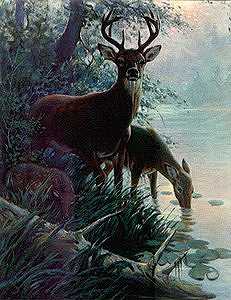1.) There have been 41 deer spotted per 100 hours on partly cloudy days.
2.) 45 per 100 hours on overcast days.
3.) 59 per 100 hours on clear days. 40% more on clear days.
B.) If high humidity is signifigant in retarding deer activities, deer should be most active on clear days. The smart hunter knows where to look for deer in various kinds of weather.
1.) Warm days--deer seek shade.
B.) On cold days--bucks often bed on slopes or on ridges facing southern exposures where sunlight filters through cover.
2.) Deer don't like windy places, When strong winds are blowing, it's best to look for deer on the lee side of the hlls, and ridges or in lowland packets of cover in goldenrods.
3.) The most important thing to remember about deer hunting is this, and only this. Bedded, feed and waters. And what trails they use, and when they use these trails.
4.) Use your eyes more than your feet.
2.) Low lying vegetation of these openings probably increases deer productivity in spring and survival rate in winter. Although a dearth of scientific documentation exists in this regard.
3.) Thirdly, and perhaps most importantly, forest openings increase the esthetic values of the landscape for everyone--hunter's and non--hunter's alike.


/